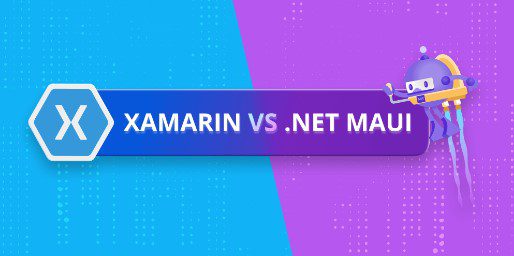If you’re a .NET developer, you’re likely familiar with the power of Xamarin.Forms for crafting mobile apps compatible with iOS, Android, and Windows. However, its limitation in supporting every platform, like MacOS, led to the birth of a superior alternative—.NET MAUI!
Understanding .NET MAUI

Xamarin Isn’t Dead; It’s Evolving Into .NET MAUI
What is .NET MAUI?
.NET MAUI, short for .NET Multi-platform App UI, is a cutting-edge open-source framework developed by Microsoft to streamline cross-platform application development. Serving as an evolution of Xamarin.Forms and integrated into the .NET 6 family, .NET MAUI enables developers to create applications for Android, iOS, macOS, and Windows using a singular codebase. This approach significantly reduces development efforts, allowing developers to focus on creating rich, native-like experiences while ensuring optimal performance on each target platform. With a unified API surface, .NET MAUI simplifies the process of accessing platform-specific features, and its use of XAML for defining the user interface makes it familiar to those with experience in other Microsoft technologies. Supporting features like .NET Hot Reload for instant code changes and integration with Blazor for dynamic interfaces using C# and .NET, .NET MAUI is a versatile and open-source solution, reflecting Microsoft’s commitment to advancing cross-platform development within the .NET ecosystem.
The Power of .NET MAUI
New Features in .NET MAUI
Discover some of the most intriguing features differentiating .NET MAUI from Xamarin and Xamarin.Forms:
- Mac Catalyst Support
- Target MacOS desktop apps effortlessly with .NET MAUI projects.
- Platform Architecture
- Integrated into .NET, .NET MAUI eliminates the need for a specialized .NET (Mono) to run.
- Single Project
- Unlike Xamarin, .NET MAUI allows cross-platform app development within a single project, supporting multiple platforms.
- Dotnet CLI Support
- .NET MAUI projects now seamlessly integrate with the .NET CLI throughout development, building, testing, and deployment.
- .NET Hot Reload
- Enjoy the convenience of hot reloading, significantly speeding up the inner development loop for day-to-day tasks.
- Handlers vs Renders
- Introducing a new UI programming model, handlers, ensuring efficient abstraction of specific UI elements.
- Shared Resources
- Share resources like images and fonts across all projects from a centralized location.
- Accessibility
- .NET MAUI prioritizes accessibility, utilizing semantic properties for accessibility values on all targeted platforms.
- MVU Pattern Integration
- .NET MAUI now supports the MVU (model-view-update) pattern, adding to the existing MVVM and RxUI patterns.
- Blazor Support
- Host Blazor web applications within a .NET MAUI container for cross-platform functionality.
- Multiple Windows Support
- .NET MAUI apps now support multiple simultaneous windows for Windows, MacOS, Android, and iPad.
The Future of Xamarin
Migrating to .NET MAUI
Microsoft ensures a smooth transition for Xamarin.Forms developers, offering comprehensive documentation on upgrading for those looking to make the shift.
Trailhead and .NET MAUI
Conclusion
The era of multi-platform app development arrives with .NET MAUI! For existing Xamarin developers, the journey to upgrade skills and apps to .NET MAUI is uncomplicated. Welcome to the future of cross-platform development with .NET MAUI, where Trailhead stands ready to guide you on the best path.